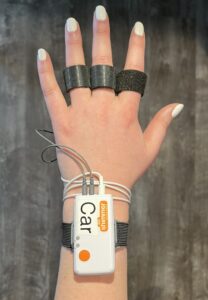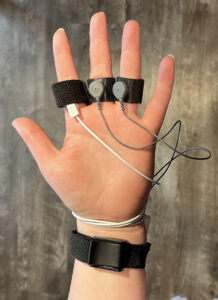

The Shimmer3 GSR+ measures galvanic skin response (GSR) and photoplethysmogram (PPG) signals. GSR data is collected by two electrodes attached to two separate fingers on one hand. These electrodes detect stimuli in the form of changes in moisture, which increase skin conductance and changes the electric flow between the two electrodes. Therefore, GSR data is dependent on sweat gland activity, which is correlated to participant level of stress (Bakker, Pechenizkiy, & Sidorova, 2011). PPG signals are collected through photodetectors on skin surfaces (usually a finger or ear-lobe) which measure volumetric variations in blood circulation, giving an accurate and non-intrusive method to monitor participant heart rates (Castaneda, Aibhlin, Ghamari, Soltanpur, & Nazeran, 2018). Together, GSR and PPG data produce an accurate depiction of participant level of stress.
The Shimmer3 GSR+ GSR and PPG sensors attach to an auxiliary input, which is strapped to the participant’s wrist as shown. Data is wirelessly sent to a host computer running iMotions EDA/GSR Module software, which feature data analysis tools such as automated peak detection and time synchronization with other experimental data.